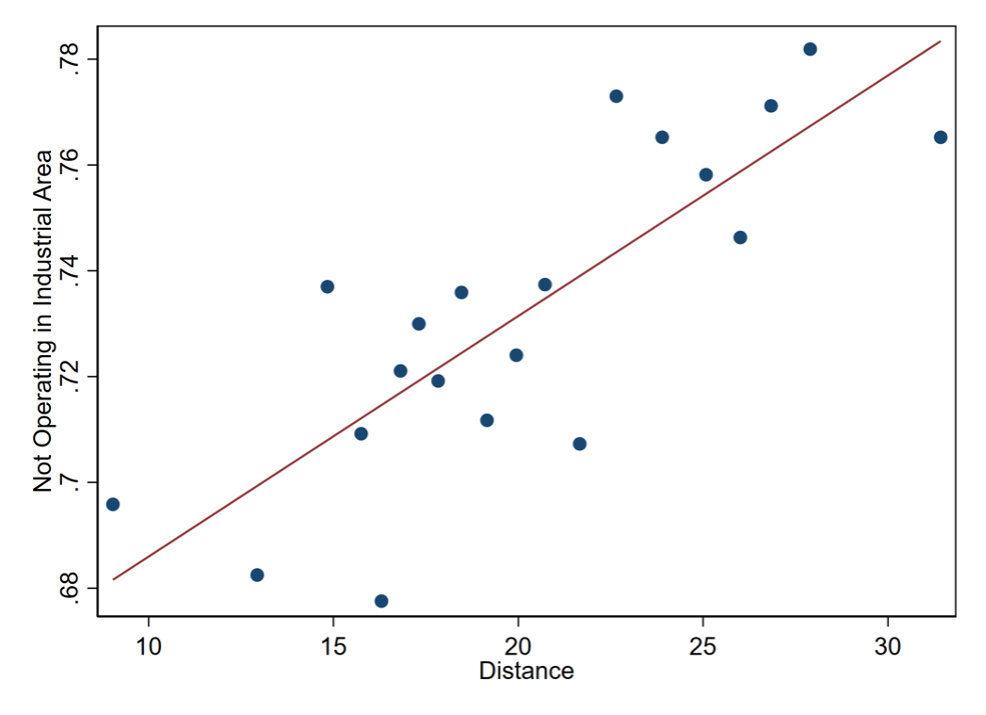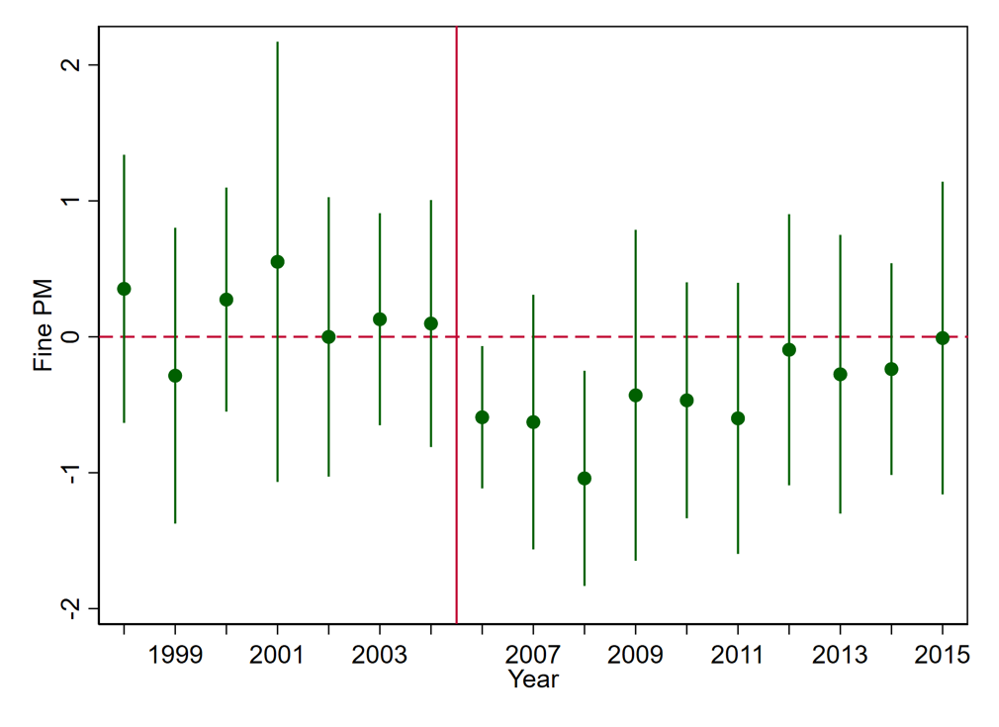CEEPR Working Paper
2025-09
Michael Gechter and Namrata Kala
Firm location decisions are one of the most important choices managers make, optimizing factors such as proximity to customers, suppliers, and useful information. At the same time, these decisions may have spillover effects on local neighbourhoods, by impacting environmental quality and contributing to local economic activity. For this reason, numerous policies attempt to change location choices of firms. The fact that firms can choose their locations based on factors we don’t measure makes estimating the impact of firm presence on the local economy difficult. Policies that shock firm location decisions are typically implemented with additional components and across metropolitan areas, making it difficult to find an appropriate comparison group and to isolate the specific effect of firm presence.
In this project we examine the effects of a policy which relocated over 20,000 firms from high-population-density areas in central Delhi to industrial areas on the outskirts of the metro area, with a main stated goal of reducing aggregate exposure to air pollution. A unique feature of this policy is that, due to a shortage of industrial plots when relocation began, plot allotment was done via a series of lotteries between 2000 and 2005, with firms actually moving between 2006 and 2010. This generates random variation in firm presence over the time period, between neighbourhoods with a greater number of firms receiving a plot earlier in the process, and those with a greater number of firms receiving a plot later in the process (conditional on the total number of firms relocated from a neighbourhood). It also generates random variation within the industrial area on who a firm’s neighbours are since, conditional on plot size and lottery year, the allocation of firms to plots was also random. We study how the policy impacted the relocated firms, and whether the effects of firm interactions revealed by its design imply that the design could have been improved. We also evaluate whether the policy achieved its desired goal of improved air quality.
Location restrictions that seek to limit pollution exposure have a long history, starting with the first zoning laws introduced in the early 20th century in New York in part to improve environmental quality (Wilson et al 2008). Harrison et al (2019) study how Indian Supreme Court-ordered Action Plans for 17 cities affected firm decisions in corresponding districts to exit or invest in pollution abatement. A primary means to reduce pollution mentioned in these action plans was relocation of polluting industries to certain designated areas. 14 of 17 Action Plans in major cities mention industrial relocation. Industrial relocation policies to combat pollution are also an increasingly popular policy tool across the developing world, such as China’s industrial relocation policy to move polluting industries outside of Beijing city limits by 2017.
Policy and Research Design
Since each plot in the industrial areas was assigned a random firm, a relocated firm’s distance from its original location is random when compared to other firms from the same location. To take advantage of this historical randomized experiment, we combine administrative data from the Delhi State Industrial and Infrastructure Development Corporation Ltd. (DSIIDC) and digitized maps of the industrial areas to identify each firm’s precise location and neighbours. Using a combination of natural language processing and manual assignment, we determine each firm’s industry based on a free text description the owner provided to DSIIDC.
The lotteries also mean that different concentrations of eligible firms left neighbourhoods throughout Delhi at different (random) times, creating variation in polluting firm presence by neighbourhood. To identify a firm’s origin location we geocoded the addresses they provided to DSIIDC, making on-the-ground visits to roughly half to validate our approach.
Effects on Relocated Firms
DSIIDC data from 2018 shows that 74% of firms in the largest industrial area were no longer operating in their assigned plot, roughly 10 years after firms first set up shop there. The probability of exiting is increasing in the distance between a firm’s original address and their location in the industrial area, as shown in Figure 1. Using the random variation in distance relocated, we can attribute 28 percentage points of the 74% exit rate to relocation alone.
Given that firms typically form geographic clusters by industry, how damaging was the policy’s random assignment of plots to firms, which spread all industries evenly across industrial areas? We take advantage of the random assignment of firms to neighbourhoods to identify the impact of different neighbourhood industrial compositions on a firm of any industry. We find that the large majority of neighbourhood composition effects on firm survival are driven by the fraction of firms in the neighbourhood with upstream and downstream linkages, and the fraction of firms producing the same product. Upstream linkages having the strongest impact, with a substantial positive effect on survival.
We then use our estimated neighbourhood composition effects to arrive at an optimal industrial area neighbourhood composition, with the goal of maximizing firm survival. We find that the optimal neighbourhood composition would have cut the effect of relocation on exit roughly in half, increasing firm survival by about 14 percentage points.

Figure 1: The Majority of Relocated Firms Were Not Operating in the Industrial Area 10 Years Later
Effects on the Neighbourhoods Firms Departed
We use the random timing of firm removal to estimate the causal impact of firm presence on neighbourhood environmental quality, specifically air pollution. We use a relatively fine definition of neighbourhood, a 1km by 1km grid-cell, which is the level at which air pollution measurements from van Donkelaar et al. (2021) are available. This allows us to test whether the relocation policy achieved its environmental objectives. A reduction in air pollution should not ex ante be taken for granted because India, like most developing countries has limited regulatory capacity. The relocated firms might move back, be replaced by other polluting firms, or pollution may increase due to, for example, the policy’s enabling growing vehicular emissions.
Accounting for the total number of firms that were relocated in a neighbourhood, we compare neighbourhoods that on average relocated a higher number of these firms earlier vs. later, with the timing randomly generated by the allotment of plots to firms via lottery. We find that the average neighbourhood impacted by relocation experiences a 1.7 microgram per meter cubed drop in particulate matter (PM) levels. This is a drop of about 1.6% of the mean fine PM concentration for the average neighbourhood. Since industrial pollution contributes about 20% to Delhi’s PM 2.5 (Sharma et. al. 2018), relocation reduced industrial pollution in Delhi by 8% for the average neighbourhood. Figure 2 breaks out the effect by year of having one percent more lottery winners in a neighbourhood by 2004.

Figure 2: Firm Relocation Decreased Pollution
Cost-Benefit Analysis
Finally, we conduct a back of the envelope cost-benefit exercise for the policy. We’ve seen that relocation reduces air pollution in the sending regions, but is costly for the relocated firms. In our cost-benefit analysis, we convert the reduction in PM levels to the statistical value of lives lost and compare this to costs associated with firm death, finding that the benefits outweigh the costs. Notably, optimal assignment of firms to plots in the industrial area taking into account neighbourhood composition effects would cut the cost of relocation roughly in half.




